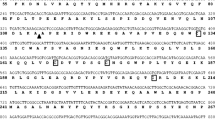Abstract
Activation-associated secreted protein (ASP) had been found in many helminthes, which was associated with pathogenesis and stage transition. A complementary DNA (cDNA) sequence encoding a putative two-domain ASP was obtained from an Angiostrongylus cantonensis fourth-stage larvae cDNA library, which we designated as AgASP. The cDNA of AgASP contains an open reading frame encoding 424 amino acids, the first 19 residues being a putative secretion signal. The expression pattern of this protein was investigated by real-time polymerase chain reaction and Western blot. We found that this protein expressed most highly in the brain-stage larvae (Lbr) of this parasite and existed in the excretory/secretory products of this stage. Immunofluorescence showed it existed in the lumen of the Lbr. The recombinant protein can be recognized by the infection sera from mice (nonpermissive host), while it cannot be recognized by infection sera from rats (permissive host). The infiltration of neutrophils in infected nonpermissive host can be lessened by immunizing this host with this protein (immunized vs control group, 13.7 ± 10.2 vs 65.5 ± 19.2). These findings suggest that this protein plays a role in the pathogenesis of human angiostrongyliasis and is worthy of further study.







Similar content being viewed by others
References
Aoki M, Sugaya H, Ishida K, Yoshimura K (1998) The role of CD4+ and CD8+ T-cells in host morbidity and innate resistance to Angiostrongylus cantonensis in the mouse. Parasitol Res 84(2):91–99
Bower MA, Constant SL, Mendez S (2008) Necator americanus: the Na-ASP-2 protein secreted by the infective larvae induces neutrophil recruitment in vivo and in vitro. Exp Parasitol 118(4):569–575
Chen J, Hu X, He S, Wang L, Hu D, Wang X, Zheng M, Yang Y, Liang C, Xu J, Yu X (2010) Expression and immune response analysis of Schistosoma japonicum VAL-1, a homologue of vespid venom allergens. Parasitol Res 106(6):1413–1418
Chen D, Zhang Y, Shen H, Wei Y, Huang D, Tan Q, Lan X, Li Q, Chen Z, Li Z, Ou L, Suen H, Ding X, Luo X, Li X, Zhan X (2011) Epidemiological survey of Angiostrongylus cantonensis in the west-central region of Guangdong Province, China. Parasitol Res 109(2):305–314
Fang W, Xu S, Wang Y, Ni F, Zhang S, Liu J, Chen X, Luo D (2010) ES proteins analysis of Angiostrongylus cantonensis: products of the potential parasitism genes? Parasitol Res 106(5):1027–1032
Geldhof P, Vercauteren I, Gevaert K, Staes A, Knox DP, Vandekerckhove J, Vercruysse J, Claerebout E (2003) Activation associated secreted proteins are the most abundant antigens in a host protective fraction from Ostertagia ostertagi. Mol Biochem Parasitol 128(1):111–114
Goud GN, Zhan B, Ghosh K, Loukas A, Hawdon J, Dobardzic A, Deumic V, Liu S, Dobardzic R, Zook BC, Jin Q, Liu Y, Hoffman L, Chung-Debose S, Patel R, Mendez S, Hotez PJ (2004) Cloning, yeast expression, isolation and vaccine testing of recombinant Ancylostoma secreted protein (ASP)-1 and ASP-2 from Ancylostoma ceylanicum. J Infect Dis 189(5):919–929
Hawdon JM, Jones BF, Hoffman DR, Hotez PJ (1996) Cloning and characterization of Ancylostoma-secreted protein a novel protein associated with the transition to parasitism by infective hookworm larvae. J Biol Chem 271(12):6672–6678
Hawdon JM, Narasimhan S, Hotez PJ (1999) Ancylostoma secreted protein 2: cloning and characterization of a second member of a family of nematode secreted proteins from Ancylostoma caninum. Mol Biochem Parasitol 99(2):149–165
He H, Cheng M, Yang X, Meng J, He A, Zheng X, Li Z, Guo P, Pan Z, Zhan X (2009) Preliminary molecular characterization of the human pathogen Angiostrongylus cantonensis. BMC Mol Biol 10:97
He HJ, Lv ZY, Li ZY, Zhang LY, Liao Q, Zheng HQ, Su WY, Rao SQ, Yu XB, Wu ZD (2011) Efficacy of combined treatment with albendazole and baicalein against eosinophilic meningitis induced by Angiostrongylus cantonensis in mice. J Helminthol 85(1):92–99
Jiang W, Hong Y, Peng J, Fu Z, Feng X, Liu J, Shi Y, Lin J (2010) Study on differences in the pathology, T cell subsets and gene expression in susceptible and non-susceptible hosts infected with Schistosoma japonicum. PLoS One 5:e13494
Li Y, Tang JP, Chen DR, Fu CY, Wang P, Li Z, Wei W, Li H, Dong WQ (2011) The use of albendazole and diammonium glycyrrhizinate in the treatment of eosinophilic meningitis in mice infected with Angiostrongylus cantonensis. J Helminthol 13:1–11
Liu Q, Yang X, Zhang M, Wang L, Liu J, Chen J, He A, Li Z, Wu Z, Zhan X (2012) Molecular characterization and immunolocalization of a protein disulfide isomerase from Angiostrongylus cantonensis. Parasitol Res 110(6):2501–2507
Ouyang L, Wei J, Wu Z, Zeng X, Li Y, Jia Y, Ma Y, Zhan M, Lei W (2012) Differences of larval development and pathological changes in permissive and nonpermissive rodent hosts for Angiostrongylus cantonensis infection. Parasitol Res 111(4):1547–1557
Schallig HD, van Leeuwen MA, Verstrepen BE, Cornelissen AW (1997) Molecular characterization and expression of two putative protective excretory secretory proteins of Haemonchus contortus. Mol Biochem Parasitol 88(1–2):203–213
Tawe W, Pearlman E, Unnasch TR, Lustigman S (2000) Angiogenic activity of Onchocerca volvulus recombinant proteins similar to vespid venom allergen 5. Mol Biochem Parasitol 109(2):91–99
Visser A, Van Zeveren AM, Meyvis Y, Peelaers I, Van den Broeck W, Gevaert K, Vercruysse J, Claerebout E, Geldhof P (2008) Gender-enriched transcription of activation associated secreted proteins in Ostertagia ostertagi. Int J Parasitol 38(3–4):455–465
Acknowledgments
This work was supported in part by a grant from the National Basic Research Program of China (2010CB530004) and the National Natural Science Foundation of China-Guangdong Provincial People’s Government of the Joint Natural Science Fund (u0632003). We are very grateful to Wen Yang and Xuerong Li for their critical reading of the manuscript and helpful comments.
Author information
Authors and Affiliations
Corresponding author
Additional information
Xiao Yang and Zhuoya Li contributed equally to this manuscript.
Rights and permissions
About this article
Cite this article
Yang, X., Li, Z., He, H. et al. Molecular cloning, expression, and characterization of a putative activation-associated secreted protein from Angiostrongylus cantonensis . Parasitol Res 112, 781–788 (2013). https://doi.org/10.1007/s00436-012-3198-x
Received:
Accepted:
Published:
Issue Date:
DOI: https://doi.org/10.1007/s00436-012-3198-x




